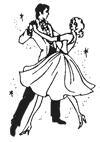 |
ROUND DANCING — CHOREOGRAPHED BALLROOMEDUCATIONAL ARTICLESMAJOR SECTIONS: Figures | Articles | Links | Alph. Index | Search | Home |
|
|
Round Dance Tips by Tim Eum—Paso DobleThe Paso Doble is a stirring and passionate dance. Its figures are patterned after actions done in Spanish bullfights with the man as the matador and the lady as his cape. Paso Doble means “Two Step” in Spanish which is reminiscent of the 1-2-1-2 … rhythm of the marching processions that preceded corridas (bullfights). Although Spanish in nature the Paso Doble was developed in France in the 1930s and thus the French names for many Paso Doble figures. The Paso Doble is one of the only dance rhythms where the MAN is the center of attention. It is he who stands proud and defiant, directing the actions of his cape, arrogantly daring the bull, or moving sharply to the attack. The lady is also proud and fiery. Her strength combines with the man’s. Together they are masters of the ring.Here are some characteristics of dancing Paso Doble:
PASO DOBLE HOLD — Use this when you need a larger frame such as for doing “The Cape.” The Paso Doble Hold may be used to modify Closed Position or Semi-Closed Position. Change man’s trail hand to rest on lady’s left upper arm. Change lead hands to be more vertical. Elbows are still the same height off the floor. APPEL — Minimize the noise (i.e. the “thump”) Appel is a stamp usually with trail foot, which takes weight. It is the first step of many Paso Doble figures. Relax knees and lower to a flat foot and then strongly go into the following step. Don’t stamp so loud that it hurts. THE CAPE (also called “Huit”) — Man may hold for 6. There are 8 steps in “The Cape” (Huit is French for 8). Starting in Semi-Closed Position, both step thru with trail foot, man then closes turning to face partner while lady makes a sharp left-face turn. Now the book says the man marches in place 6 steps. However, it is okay to simply HOLD instead. The lady in the meantime takes her third and fourth steps across in front of the man, and then on the fifth step sharply turns right-face. The lady then steps forward on her sixth and seventh steps to face man and finally closes on her eighth step.
Tim Eum originally prepared these Tips for
|
 |
|
|
Page last revised